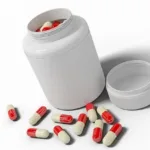Apremilast is a prescription medication available as an oral pill for treating certain inflammatory conditions, including psoriasis, psoriatic arthritis, and oral ulcers associated with Behçet’s syndrome.
It is a type of drug called a phosphodiesterase 4 (PDE4) inhibitor, which works by blocking the activity of an enzyme called PDE4.
This enzyme is involved in the inflammation process, and blocking it helps to reduce inflammation and its associated symptoms.
Apremilast was first approved by the US Food and Drug Administration (FDA) in 2014 for the treatment of psoriatic arthritis, and in 2015 for the treatment of moderate-to-severe plaque psoriasis. Since then, it has also been approved for the treatment of oral ulcers associated with Behçet’s syndrome.
Apremilast is marketed by Celgene Corporation, which is now a subsidiary of Bristol Myers Squibb following a merger in 2019.
Celgene initially developed Apremilast and obtained FDA approval for its use. After the merger, Bristol Myers Squibb took over the marketing of the drug. Apremilast is sold under the brand name Otezla.
Apremilast Class: Phosphodiesterase Inhibitor
Apremilast Category: immunomodulatory drug
| You may also like to read: |
Apremilast (Otezla) FDA-approved indications:
The FDA has approved Apremilast (Otezla) for the following indications:
- Moderate to severe plaque psoriasis in adult patients who are candidates for phototherapy or systemic therapy.
- Active psoriatic arthritis in adult patients, alone or in combination with DMARDs (disease-modifying antirheumatic drugs), such as methotrexate.
- Oral ulcers associated with Behçet’s syndrome in adults.
| You may also like to read: |
Apremilast (Otezla) Dose:
The usual daily maintenance dose of Apremilast (Otezla) for the treatment of plaque psoriasis, psoriatic arthritis, and oral ulcers due to Behcet’s syndrome is 60 mg in two equally divided doses.
Treatment is usually initiated in a low dose and titrated upwards as mentioned in the table below [Ref]:
| Apremilast (Otezla) Dose | Total Daily Dose | Am | Pm |
| Day 1 | 10 mg | 10 mg | – |
| Day 2 | 20 mg | 10 mg | 10 mg |
| Day 3 | 30 mg | 10 mg | 20 mg |
| Day 4 | 40 mg | 20 mg | 20 mg |
| Day 5 | 50 mg | 20 mg | 30 mg |
| Day 6 and onwards | 60 mg | 30 mg | 30 mg |
The maximum recommended dose in patients with severe renal impairment is 30 mg orally once a day.
| You may also like to read: |
Apremilast (Otezla) Contraindications:
There are a few contraindications to the use of Apremilast (Otezla). These include:
- Hypersensitivity:
Apremilast is contraindicated in patients with a known hypersensitivity to the drug or any of its components.
- PDE4 inhibitors:
Apremilast is a PDE4 inhibitor, and its use is contraindicated in patients who are taking other PDE4 inhibitors, such as roflumilast.
- Pregnancy:
Apremilast may cause fetal harm if taken during pregnancy. It is contraindicated in pregnant women and women who are planning to become pregnant.
| You may also like to read: |
Apremilast (Otezla) Side effects:
Some of the important side effects of Apremilast are mentioned in the table below:
System | Side Effect |
| Gastrointestinal | Diarrhea, nausea, vomiting, abdominal pain |
| Psychiatric | Depression, suicidal behavior, or ideation |
| Neurological | Headache |
| Dermatologic | Skin rash |
| Musculoskeletal | Back pain, muscle spasms |
| Respiratory | Nasopharyngitis, upper respiratory tract infection |
| Metabolic | Weight loss |
Apremilast and Depression:
Depression is a possible side effect of Apremilast, although it is not a common side effect. In clinical trials, depression was reported in a small percentage of patients taking Apremilast, and it was generally mild to moderate in severity.
Patients taking Apremilast should be aware of the potential for depression and should promptly report any symptoms of depression to their healthcare provider, such as feelings of sadness, hopelessness, loss of interest in activities, changes in sleep patterns, or thoughts of self-harm.
In some cases, Apremilast may not be the best treatment option for patients with a history of depression or other mood disorders.
| You may also like to read: |
Apremilast (Otezla) Drug Interactions:
Drug Class | Examples of Drugs | Degree of Interaction |
| Strong CYP450 3A4 Inhibitors |
| Increase Apremilast levels Moderate to Strong |
| Strong CYP450 3A4 Inducers |
| Decrease Apremilast levels Strong |
| P-glycoprotein (P-gp) Inhibitors |
| Increase the drug levels Moderate to Strong |
| P-glycoprotein (P-gp) Inducers |
| The effect is not well known but may decrease the drug levels Unknown |
| CYP450 2C8 Substrates |
| Otezla increases the levels of these drugs in the blood increasing their side effects Unknown |
| CYP450 2C9 Substrates |
| Otezla increases the levels of these drugs in the blood increasing their side effects Unknown |
| CYP450 2C19 Substrates |
| Otezla increases the levels of these drugs and increases their side effects Unknown |
| CYP450 3A4 Substrates |
| Otezla increases the levels of these drugs in the blood and increases their side effects Weak to Moderate |
| Methotrexate | May increase the risk of liver toxicity | Otezla and Methotrexate, when combined, increase liver toxicity Unknown |
| You may also like to read: |
Apremilast (Otezla) Mechanism of action (MOA):
Apremilast is a medication that works by inhibiting the activity of an enzyme called phosphodiesterase 4 (PDE4).
PDE4 is involved in the regulation of inflammation and immune response. By inhibiting PDE4, it reduces the production of certain pro-inflammatory cytokines and increases the production of anti-inflammatory cytokines.
This helps to reduce inflammation and modify the immune response, which can lead to improvement in certain inflammatory conditions.
Pharmacokinetics | Information |
| Bioavailability | Approximately 73% |
| Protein binding | Greater than 99% |
| Metabolism | Primarily hepatic metabolism via CYP3A4, with minor contributions from CYP1A2, CYP2A6, CYP2B6, CYP2C8, CYP2C9, CYP2C19, and CYP2D6 |
| Half-life | Approximately 6-9 hours |
| Excretion | Approximately 58% of the dose is excreted in the feces, and approximately 39% is excreted in the urine |
| Time to peak concentration | Approximately 2-3 hours |
| Peak concentration | Achieved within 1-2 days of starting treatment |
| Steady-state concentration | Achieved within 7-14 days of starting treatment |
| Food effect | It can be taken with or without food, although taking it with food may reduce the risk of gastrointestinal side effects |
| You may also like to read: |
Apremilast cost:
According to GoodRx, as of February 2023, the average retail price for:
- 10mg (30 tablets): $2,800,
- 30 mg (30 tablets): $3,600.
Apremilast Vs Roflumilast: Are they the same:
Roflumilast is also a phosphodiesterase inhibitor, however, it is indicated only for the treatment of COPD.
Here is a table comparing Apremilast vs Roflumiast:
Features | Apremilast | Roflumilast |
| Mechanism of action | PDE4 inhibitor | PDE4 inhibitor |
| FDA-approved indications | Psoriasis, Psoriatic arthritis | COPD |
| Chemical structure | Small molecule | Small molecule |
| Target organs | Skin, Joints | Lungs |
| Side effects | Nausea, diarrhea, abdominal pain | Nausea, diarrhea, abdominal pain, increased risk of respiratory infections, cough |
| You may also like to read: |




